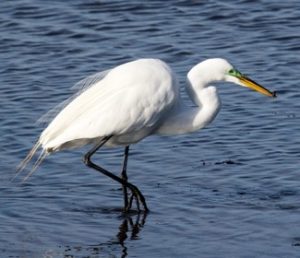Tidal salt marshes provide essential ecosystem services to the coastal communities of Barnegat Bay. These areas are the transition zones in estuaries, providing nursery, forage, and nesting habitat for fish and other wildlife, and display greater complexity and primary production than other nearby habitats. Tidal salt marshes also provide flood protection, water quality improvements and biogeochemical cycling, all of which benefit the surrounding communities. A 2012 study valued the ecosystem services of saltwater wetlands in Barnegat Bay at $155 million per year!
The mainland shores of Barnegat Bay are fringed with coastal wetlands whose vegetation form and character are largely controlled by the tidal regime and salinity of neighboring bay waters. The saltwater wetlands are subject to high salt concentrations (up to 28-30 ppt), are regularly inundated by the tide, and are typically flat meadowlands dominated by Spartina species. In these tidal wetlands, Spartina alterniflora, S. patens, Juncus gerardi, and Salicornia virginica are the characteristic forms of a New England type salt marsh community (Nixon, 1982; Tiner, 1985). The smooth cordgrass (Spartina alterniflora) dominates low marsh habitat, proliferating in intertidal areas. Smooth cordgrass occurs in two growth-forms (short- and tall-form) with a taller form growing along tidal waterways, largely due to better soil aeration and greater supply of available nutrients.
Low elevation depressions within the salt marsh are often highly saline due to a combination of impeded drainage, irregular tidal flushing, and intense evaporation (Redfield, 1972). Except for saltworts (Salicornia spp.) and blue-green algae, these “salt pannes” are often largely devoid of vegetation.
Salt-meadow cordgrass (Spartina patens), spike grass (Distichlis spicata) and black grass (Juncus gerardi) dominate higher elevation marshes, which are only irregularly flooded by saline waters. Shrub species such as salt marsh elder (Iva frutescens) and groundsel tree (Baccharis halimifolia) commonly occur on areas of slightly higher elevation within the salt marsh (e.g., spoil mounds adjacent to ditches) (Sneddon et al., 1995). Common reed (Phragmites australis), narrow-leaved cattail (Typha angustifolia), and bulrushes (Scirpus spp.) commonly occur as a narrow fringe along the upland edge due to decreased tidal flooding, greater freshwater runoff, and thereby lower salinity levels.
Proceeding upstream along some of the larger streams and rivers tributary to Barnegat Bay, salinity levels drop and plant communities diversify. Big cordgrass (Spartina cynosuroides), various sedges (Scirpus spp.), salt marsh fleabane (Pluchae purpurascens), and swamp rose mallow (Hibiscus moscheutos) add greater variety to this brackish marsh community.
Tidal freshwater marshes occur where the water becomes fresher (below 0.5 ppt salinity) but still remains tidally influenced (Sneddon et al., 1995). The lower reaches are dominated by forbs such as arrowhead (Sagittaria latifolia), pickerelweed (Pontederia cordata), and arrow arum (Peltandra virginica). Tall stands (> 2 m high) of wild rice (Zizania aquatica) occur along the upper reaches of some tidal freshwater marsh areas. The common reed, an aggressive invader, will colonize and dominate brackish and freshwater tidal marsh areas, especially in areas that have been disturbed due to ditching and dredge-spoil dumping (Sneddon et al., 1995; Windham and Lathrop, 1999).
Saltmarshes are characterized by high biomass and organic productivity values. Although standing crops are high, herbivory remains low, resulting in the generation of large amounts of detritus that support detritus-based food chains. The export of a portion of the detritus accumulating in saltmarshes may stimulate productivity in contiguous waters. Leaves and stems effectively increase the substrate surface area for epiphytic flora and fauna, thereby enhancing the primary and secondary productivity of the habitats. The epibiota also provide a rich food supply for fish and invertebrates.
A canopy of dense leaves typically found in the coastal wetlands causes lower amounts of solar radiation than in surrounding unvegetated areas. Protected from excessive illumination and solar radiation, this shaded habitat appears to be beneficial to the benthos. The lateral zonation observed in these wetlands presents a diversity of habitats for the protection and proliferation of epiflora, epifauna, benthic infauna, fishes, birds, and various wildlife species. In the Barnegat Bay-Little Egg Harbor estuarine system, saltmarshes support numerous endangered, threatened or rare species.
Apart from their high production, wetlands are effective in the removal of excess nutrients, metals, and other pollutants from surface waters. The sequestration of nutrients and chemical contaminants is potentially important in water quality protection of estuarine waterbodies. Adsorption of contaminants onto suspended particulates and their subsequent deposition is the primary means of removal. Leaves, stems, and roots reduce wave and current action and facilitate sediment deposition. In addition, the roots and rhizomes bind sediments, stabilize the substrate, and mitigate erosion. Saltmarshes provide natural flood control in the watershed because they tend to slow and hold water. The broad expanses of saltmarshes also stabilize banks and protect the shoreline from other destructive natural and human forces.
This is an excerpt from Chapter 6 of the “Scientific Characterization of the Barnegat Bay-Little Egg Harbor Estuary and Watershed” (September 2001).

